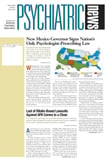State officials sounded a note of desperation about the rising costs of health care at the winter meeting of the National Governors Association, according to the New York Times (February 25, 2002).
The principal culprit? Spending on prescription drugs through the Medicaid program. The response in more than 40 states has been to try to find legislative and other remedies to stem the financial hemorrhaging (Psychiatric News, January 18; February 1).
In the private sector, employers are turning to a three-tier system of providing prescription-drug benefits and to larger copays in their own efforts to contain costs (Psychiatric News, October 19, 2001; January 18).
Ernst R. Berndt, Ph.D., a professor of applied economics at the Massachusetts Institute of Technology’s Sloan School of Management, wrote that utilization, rather than price, has been the primary driver of increased pharmaceutical spending.
That conclusion appears in the article “The U.S. Pharmaceutical Industry: Why Major Growth in Times of Cost Containment,” first published in Health Affairs in the March/April 2001 issue and reprinted in “The Value of Rx Innovation: A Primer From Health Affairs” last year.
Berndt identified four factors that increased utilization, even though cost-containment measures were being applied in other aspects of health care.
In an interview with Psychiatric News, he speculated about the future role of those factors and their applicability to drugs used to treat mental illness.
Below Radar Range
Berndt relied on the common-sense reasoning of a 19th-century economist for his first factor. Alfred Marshall proposed the idea that cost cutters will likely focus on big-ticket items, rather than on goods or services that make up a smaller part of a total budget.
From 1960 through 1998, hospital care and physician services together made up more than 50 percent of health care expenditures, with prescription-drug costs actually declining as a percentage from 10.0 percent in 1960 to 7.9 percent in 1998, the last year for which Berndt had data.
Thus, according to Berndt, prescription drugs were not on the radar screen of cost cutters until recently because of their relative unimportance in the total scheme of health care costs.
But, he added, data reported in the January/February issue of Health Affairs show a 17.3 percent increase in prescription-drug spending for 2000, compared with a 6.9 percent increase overall in national health expenditures. So, it’s not surprising that both employers and governmental officials are taking aim at a now highly visible target.
Unintended Consequences
Berndt noted that the thriving economy contributed enormously to the greater utilization of prescription drugs because employers were willing to offer attractive benefits to retain employees. In 1965 private insurance covered 3.5 percent of prescription-drug spending; in 1990, the figure was 34.3 percent, and in 1998, 52.7 percent.
Information technology played a key role by making insurance transactions more convenient and less costly. Until the 1990s consumers with third-party insurance typically paid the full cost of drugs and then submitted receipts for reimbursement. Today, payment is handled electronically. These electronic transactions can be monitored easily by pharmaceutical benefit managers.
Researchers find, according to Berndt, that per capita drug use is strongly associated with the extent of drug coverage and with amounts required for copayments.
Berndt said, “With the economy weakening and employers increasing copayments, expanded drug coverage in the private sector does not appear to be a likely source of greater utilization in the near future.”
With both Republicans and Democrats pushing for some form of prescription-drug benefit for the Medicare-age population, however, expanded drug coverage in the public sector likely will promote greater utilization.
Successful New Products
Using data from IMS Health, a for-profit provider of pharmaceutical information, Berndt found that since 1997 about 46 percent, on average, of drug-spending growth is attributable to new pharmaceutical products, about 32 percent to volume and mix changes involving older drugs, and 22 percent to the price growth of older drugs.
For his analysis, he accepted the IMS Health definition of “new product” as any product having a new National Drug Classification code that was launched during the 12 months ending with the last calendar quarter.
In 2001 the pharmaceutical industry spent an estimated $30.3 billion in drug development, a 16.6 percent increase over research and development expenditures during 2000 (see story on
page 8). Of that amount, $7.3 billion was spent on central nervous system drugs, the great majority of which are directed to mental disorders.
The impact of marketing on the cost of drugs is much more complicated than is suggested by stories in the popular press about the pharmaceutical industry’s courting of the medical profession, according to Berndt.
Nontraditional Marketing
He believes that research and diffusion of information that informs consideration of new diagnostic criteria and treatment guidelines are “nontraditional” forms of marketing that benefit patients and also increase the use of pharmaceuticals.
Even “traditional” marketing efforts must be considered in light of the nature of pharmaceuticals. Berndt classifies prescription drugs as “experience goods,” as opposed to “search goods.” The former must be experienced for a consumer to be persuaded of their value, because their effect is unknown and can be idiosyncratic. The contrast, in everyday terms, is between a lipstick and a pencil. Advertising-to-sales ratios tend to be higher for experience goods, since a consumer must be persuaded to try the good, as opposed to merely finding a good that meets a felt need.
Berndt estimated that in 1999 pharmaceutical companies spent $13.9 billion on marketing, which yielded a marketing-to-sales ratio of 12.3 percent. The ratio is higher than for a company selling search goods (Sony at 4.7 percent), but lower than for another company selling experience goods (McDonald’s at 21.1 percent).
The future, according to Berndt, promises more aggressive marketing efforts. New products will continue to be launched. Many of these products will be competing with existing products. Consumers, as well as the medical profession, are demanding more information about the effects and efficacy of pharmaceuticals. ▪
